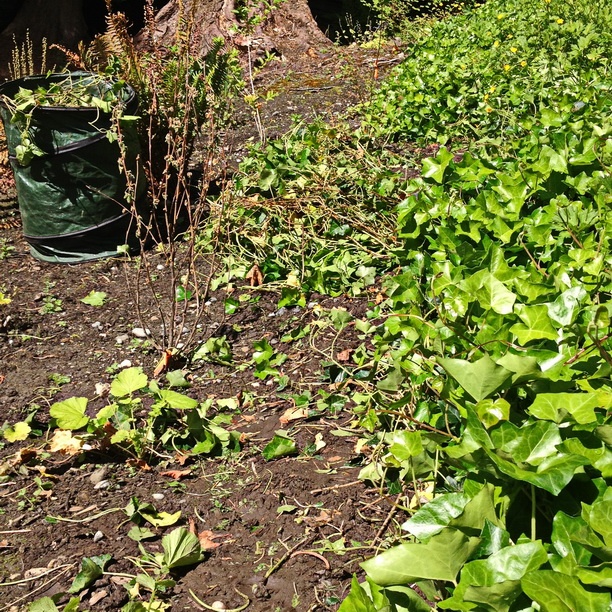Backyard Singular, then Backyards Plural – My Adventure in Backyard Forest Restoration
My adventure with forest restoration began when we purchased an unremarkable house because we were enchanted by a small year-round creek in the backyard. The stream, however, was completely channelized by ivy — blanketing the understory and climbing far up into the canopy of surrounding trees. Rescuing the natural environment from suffocation by ivy became a mission for me.
I began with a working knowledge of our lowland woodland species, but no training in forest restoration. I based what I did on what I could manage on my own, beginning with the ivy growing up the trees. I first cut the vine stems at the base of the trees in order to cut off their nutrient and water supply. The ivy in the trees did not die as quickly as I might have wished, but die it did, and then I could more gradually work to remove it from the surrounding area.
Removing ivy is a winter sport when the summer plants have died back and shallow roots let go in the wet soil. Starting from the edges I began pulling strands, watching them pull through the carpet of ivy long distances away, and clipping them when they no longer came easily. I found this very satisfying.
Pulling and clipping removed the longer vines, but left a covering of ivy still rooted in the ground which I could roll up like a carpet, removing the roots as I went.
Between the initial stem cutting around the trees, the pulling and clipping of the long vines, and the carpet rolling, I was successful in eradicating, almost entirely, the ivy from our backyard forest. In subsequent years, it was relatively easy to spot and remove the occasional, re-emergent ivy plant.
Finding native plants hiding under the ivy was an unexpected treat. I found Trillium, Sword Fern, Lady Fern, Shield Fern, Vine Maple, Indian Plum, Fringecup, Piggyback, Coltsfoot, Salmonberry, and even Skunk Cabbage.
At first, I thought the ivy would need to be carried to my front yard (very heavy, bulky and awkward) and put in the yard waste bin. Then I found out the City recommended simply building piles and letting them compost in place – which happened surprisingly quickly.
I wanted to add diversity to the area and give the creek the shade it needed in summer. The King County Conservation District’s bareroot sales are an inexpensive way to add native trees and bushes to the landscape. The plants come in bunches of 10 for a very reasonable price. Now, I needed much more territory to restore if I wasn’t going to let my new plants go to waste.
I began asking my neighbors one by one if they would mind if I began to restore their property along the creek. I kept adding new backyards until I hit my capacity at 5 backyards. Working outside in the winter, it would get so dark my family would come looking for me. I didn’t want to waste a minute of winter twilight in those short days.
Those huge piles of ivy are now just a memory. The ivy was the largest mass but some other invasives needed control. I didn’t find much holly and I have managed it with cutting it back as needed. Yellow Archangel planted years ago by a neighbor has been a challenge to control along the stream bank. I also found some limited Japanese Knotweed higher up the creek but luckily our shady spot doesn’t create good conditions for it, and I was able to control it with persistence. English Laurel is an ongoing menace, and I work to not let it establish further, but I understand my neighbors’ wish for the green barrier it creates, so I try to accept it as part of living amicably in a community.

